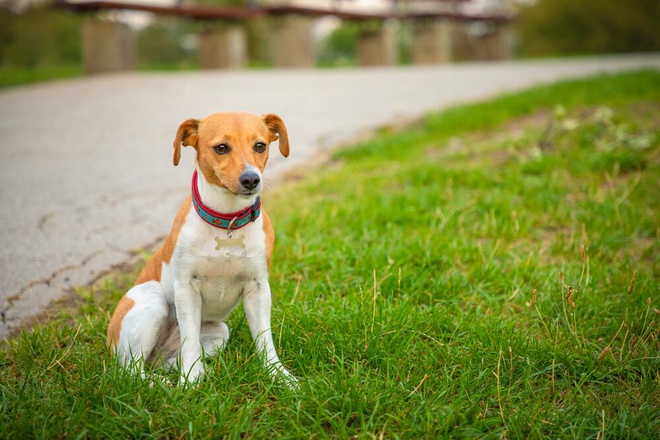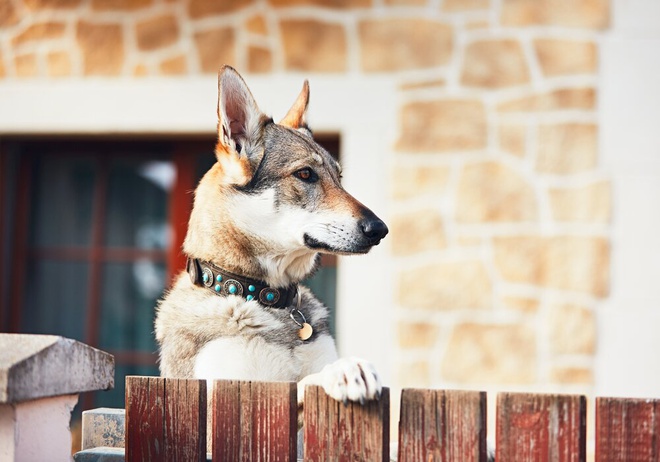How to train a runaway dog?
A runaway dog is an owner’s worst nightmare. Runaways can be explained by many factors and can be corrected with several methods.

Reading time : 8 min
Pets who like to unexpectedly leave their home are a great source of concern for their owners. It is therefore essential to understand the cause of such behaviour.
A runaway dog can come from the pet’s bad habit but also an owner’s inadequate behaviour, even if it seems harmless at first. It can make the owner anxious, but it can also have serious consequences. In this article, we will explain why dogs run away, and how to prevent any escaping attempts.
TOPICS
The risks of a runaway pet

Having a pet run away is a serious matter and should not be taken lightly. It is important to train your canine friend not to run away because while the runaway dog is at risk, the owner is also responsible for their actions.
The escaped dog could be stolen
Even if a dog is microchipped, they can still be stolen. Indeed, when most people find a lost dog, they will go to the vet to try to find the owner. But some ill-intentioned or dishonest people may decide to keep the dog or resell them, especially if they’re a popular and sought-after breed.
The runaway dog could get injured
When a pet wander, they can get seriously injured or even killed. They can get hit by a car or intentionally killed by a malicious person. If they have been in an accident, their injuries will result in veterinary costs, which can be substantial.
The owner is responsible for his dog
If a dog is responsible for an accident, or assaults or injures someone, even if unintentionally, the owner is responsible for the animal's actions and can face having their animal put down.
The owner could go to jail if something happens
Similarly, if the dog is responsible for an accident causing the death of one or more people, the owner of the animal will be held criminally responsible.
Seeing your dog repeatedly run away can undoubtedly be discouraging for the owner. However, considering the risks to the animal and the owner, it seems wise to correct this behaviour as soon as possible.
Why do dogs run away?

Before trying to eradicate annoying and potentially dangerous pet behaviour, it may seem important to understand the causes. There may be many reasons for running away.
Hunger
Hunger can be a factor in running away. Indeed, if the weight of a dog is judged to be problematic by the veterinarian, the owner will be advised to adapt or reduce their diet. This is undoubtedly a very good thing for their health.
However, unless the veterinarian advises otherwise or there is an emergency, this readjustment of food must be done in a completely painless way for the pet. In other words, if a certain dog breed has obesity tendencies, like Labradors, the owner must provide a suitable diet.
It will be necessary to reduce their portions little by little so that they do not suffer. Otherwise, your dog may be tempted to run away to go eat around the neighbourhood.
Predatory instinct
Even when domesticated, most pets obey their primary instincts. All dogs have a predatory instinct that is developed and that can therefore cause them to run away. They may become excited at the sight of a running cat.
It is partly for this reason that it is not advised to encourage your pet's predatory instincts, even when a puppy.
Lack of exercise
For dogs, it is also important to differentiate between potty walks and exercise walks. Most dogs need physical exercise and mental and olfactory stimulation. This is important for their physical and mental health.
Boredom and loneliness
The outside world is full of exciting noises, enticing smells, children playing and many interesting solicitations. A bored dog may be tempted to run away and go discover the world as soon as the door opens.
To counteract this bad habit, dog owners can establish a routine of taking their dogs for a long walk every day when they come home. Some breeds of dogs are particularly keen on exercise and walks. The hound will likely run away if not sufficiently exercised.
Hot weather
Hot spells can be critical for runaway dogs. Some dogs run away exclusively to join females in heat that they sense in the neighbourhood. Similarly, females in heat may run away when they sense smell males nearby. Neutering and spaying of males and females almost systematically overcome this problem.
Fear
Dogs are fearful of loud noises. Thunder or fireworks can be all it takes for a dog to be terrified and run away. In their disoriented state, it may be difficult for them to find their way back home. A simple solution is to not open any doors or windows and to reassure your pet.
10 questions to test your pet training knowledge
Do you know everything there is to know about training dogs and cats? Answer our 10 questions to find out!
The solutions against runaways

Sometimes, identifying the causes of runaways is unfortunately not enough to solve them. It is then possible to resort to solutions that will help contain the desire of dogs to run away.
Dog fence for the garden
Fencing your property can be effective for a dog. Of course, the height of the fence should be chosen according to the size of the dog. While a 3 ft. (one-meter) high holds back a small dog such as a Chihuahua or a Maltese, it will not prevent a Boxer or a Doberman from running away.
What size should the fence be?
A dog fence is usually between 3 to 9 ft. (one and three meters) high. This can easily deter puppies or some dogs from going for ambles. That said, other freedom-loving dogs will not hesitate to dig under the fence to get away.
How to stop your dog from digging under a fence?
Sometimes it's just a matter of boredom. Outdoor activities, long walks, and a little more quality time can improve things significantly. Making sure your pet gets plenty of exercise will allow them to expend that extra energy.
In other cases, this may not be enough. If your dog continues to dig, you’ll need to patch up the bottom part of the fence. Here are some ideas of how you can do this.
- Bury chicken wire under the fence. Dig a trench under the fence deep enough to comfortably accommodate the chicken wire. Backfill the trench until the chicken wire is completely covered.
- You can also place large rocks at the bottom of the fence line.
- Add chain-link fencing and anchor it to the bottom of the fence.
- You may consider installing an L-shaped fence (bent at a 90-degree angle). The wire fence will deter your dog from approaching the fence.
- Use smelly deterrents like pepper or pepper spray to deter your dog.
Anti-runaway fences
Anti-runaway fences, also known as electric fences, are invisible fences meant to deter any pet from going outside the garden.
How much do electric dog fences cost?
The kit consists of an antenna wire, a transmitter box, a receiver box, and an electric collar. Anti-runaway fences are invisible. The link between the anti-runaway fence and the collar is through a receiver. The price of an anti-runaway fence is around $180.
How do electric dog fences work?
The owner will have to mark out the area that the pet is allowed to cover. To do this, the owner simply buries the transmitter and the antenna wire in a closed circuit around the perimeter of the garden. The electric collar with the receiver attached to the pet's neck receives the waves emitted by the transmitter.
The dog can walk around the perimeter at will. However, when the pet approaches the anti-runaway fence, the collar emits a beep and then sends an electric shock if the pet continues to approach. The dog associates the proximity to the virtual fence with an unpleasant experience, this is called negative reinforcement.
Anti-runaway collars
These wireless dog collars are suitable for all sizes of dogs and can be adjusted. They consist of a box containing a battery and a radio receiver attached to the collar and remote control.
These anti-runaway collars are used in recall training. When the owner calls the dog back, the dog must return to the call. If the dog does not return, the owner activates the remote control, which triggers sound or electrical stimuli.
The owner can also activate the remote control if they think that the dog is wandering too far away. For a few days, the dog assimilates the separation from their owner as an unpleasant, painful experience.
While fences and anti-runaway barriers can be permanent solutions, this is not the case with anti-runaway collars which must be temporary.
The limitations of these anti-runaway systems
If the anti-runaway fence or the anti-runaway collar were to malfunction for one reason or another, the dog will soon want to run away without looking back. But they will not have learned anything about what is expected of them.
Moreover, it appears that the apprehension of electrical shocks can be the cause of behavioural disorders. Psychological imbalances, aggressiveness, lethargy, or compulsive licking are likely to occur.
Using a GPS tracker

GPS trackers for dogs seem to be an interesting alternative for pets and reassuring for their owners. There are various GPS trackers; some are integrated into the collar; others are attached to the animal's collar. The latter is a good solution because some dogs do not like to wear a collar and prefer to wear a harness.
What is a GPS Tracker
A pet GPS is a small, lightweight device that does not interfere with the pet's movements. It is made of resistant materials and is, of course, waterproof so that it can follow the animal in all their wanderings. It usually works with a smartphone application, which makes it extremely convenient and easy to use.
There are GPS with and without a subscription, but GPS with a subscription are undoubtedly more efficient when it comes to tracking living animals on the move. Some GPS collars can send the position of the pet in real-time (every 10 seconds) without any distance limit.
GPS tracker as a training tool
Unlike other devices, GPS trackers do not work against the education of the dog. Some GPS devices have a training programme that is similar to conditioning. This consists of vibrating the GPS tracker from the smartphone app as soon as the dog eats.
Over time, the dog will associate the vibration of the GPS collar with their meal. When the dog is late returning, simply trigger the collar vibration to see it return.
Furthermore, if the lost dog is found by a third party or picked up by the dog warden, the GPS tracker is an unequivocal indicator that the stray dog has an owner. A tool that offers an additional chance of finding your pet
Conclusion
In any case, it is important to remember that, for their safety, a pet must be vaccinated, identified, and sterilised. First, because sterilising a dog is an inexpensive option compared to the risks involved and can put an end to runaways. That said, if runaways persist, identification is a valuable aid in the process of finding the pet, which is not insignificant. Educating your pet can help reduce the number of runaways.
While there are physical solutions, it is important to choose a durable device that is not intrusive to the animal. There are many options, but the causes of runaways associated with the GPS tracker seem to be an enlightened choice for both the pet and their owner. Discover the functionalities of dog trackers and never lose your pet again!
Continue reading our guide
This article is a part of a complete guide on the subject. Do not miss the next chapters.
Do you know everything there is to know about training pets?
Answer our 10 questions to test your pet training knowledge.
